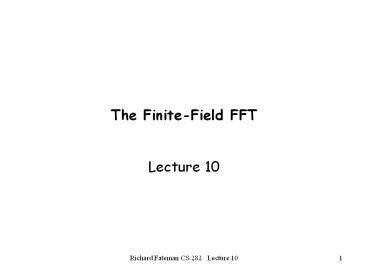The Finite-Field FFT - PowerPoint PPT Presentation
1 / 21
Title:
The Finite-Field FFT
Description:
If we knew {ai} ahead of time we could pre-process the coefficients ... If we keep the polynomial fixed, and evaluate at many points, we can do better, as we will see. ... – PowerPoint PPT presentation
Number of Views:18
Avg rating:3.0/5.0
Title: The Finite-Field FFT
1
The Finite-Field FFT
- Lecture 10
2
Intro
3
If we knew ai ahead of time we could
pre-process the coefficients
4
Simultaneous Evaluation at Many Points
If we keep the polynomial fixed, and evaluate at
many points, we can do better, as we will see.
For specificity in notation, let us evaluate A(x)
at n given points, x0 , ... , xn-1 . Let us
represent the problem as a matrix multiplication
Is this perfectly clear?
5
Roots of Unity
It is especially convenient for subsequent
operations to choose the points
specially Definition wn is a primitive nth
root of unity in a computation structure (e.g.
finite field), if wnn 1 but for no m such that
0 lt m lt n is wnm 1. Examples In the finite
field of the integers mod 41 ( Z41 ), the
element 3 is a primitive 8th root of unity. In
Z3 the element 2 is a square-root of unity, since
22 4 1 mod 3. Over the complex numbers, wn
e2 p i / n .
6
Definition of Fourier Transform
Definition A Fourier Transform (FT) is a
sequence of n points constituting the evaluation
of a polynomial with coefficients a0 , ...,
an-1 at the points w0 , ..., wn-1 where w
is a primitive nth root of unity. That is,
the Fourier Transform can be thought of as the
left hand side of the equation on the next slide.
7
FT is just a matrix multiplication
for convenience we will denote it this way
stop here and understand this.
8
Computing
Let n be even 2k.
9
Computing
10
Computing
We have accomplished a 2k Fourier Transform with
2 size k Fourier Transforms plus some O(n)
operations and powerings of w (which can be
precomputed).
11
How fast is this FFT?
A principal item of interest is the running time
for the FFT. If the time to perform an FFT of
size 2k is T(2k), then from our expression
above, T(2k)2T(k)O(k ). Iterating this formula
gives (where rlog2 k) T(2k)2r T(1) O(rk)
O(n log n). Thus this trick reduces the O(n2)
algorithm (of n applications of Horner's rule),
to O(n log n) operations. This is a very good
speedup, and was allegedly known by Gauss and
others, until it was popularized by Cooley and
Tukey.
12
We have to be able to invert the FFT
Interpolation!
That is, we are given a set of evaluation points
(powers of a root of unity) and asked to provide
a polynomial which assumes given values at those
points. The inverse of Fn is a matrix Gn where
the (i,j)th element is wn-ij /n, where we have,
somewhat unconventionally, numbered the rows and
columns so that the 0,0 element is at the top
left.
13
The Inverse of Fn
It looks rather like Fn with w-1 in place of w,
and with a 1/n out front. So whatever
computation structure we have needs to allow us
to compute 1/n, as well as have roots of unity we
can use.
14
Proof that I Fn Gn
15
How hard is it to find primitive roots of unity?
Not hard.
16
How many of these can we find?
17
The algorithm, written simply, recursively
18
The insides
19
Can the FFT be improved?
Basically, it continues to be a major industry to
come up with improved designs, variations and
implementations of the FFT. http//www.fftw.org/
is the home page for the fastest FFT in the
West. Limitations that can be modified power of
2, (vs power of 3 or product-of primes) in-place
transforms, cache performance.
20
Since I usually badmouth asymptotic results, is
this practical (e.g. for polynomials)?
Yes Enough of the time that it has been
implemented in a few systems. No It is not the
default for any computer algebra system.
Probably not fast enough for routinely-small
routinely-sparse routinely many-variables.
Coefficients must be bounded in some effective
way. Other techniques (e.g. Karatsuba) sometimes
prevail.
21
Benchmark
- One benchmark set up to favor FFTs suggest that
computing f(x)2 where f is a dense polynomial
over a single-precision-size finite field, is
best done by FFT only if deg(f)gt96. - How favored?
- (x1)96 has many bignum coefficients, so a real
comparison might need 3 or 4 FFTs CRA bound
computation. - For f(x) sparse, FFTs would do almost as much
work, but the competition would not.































